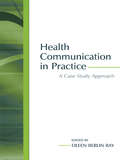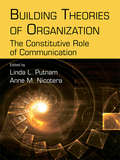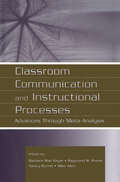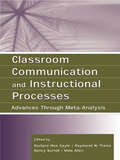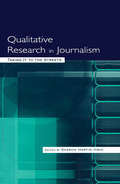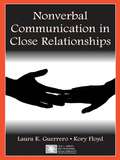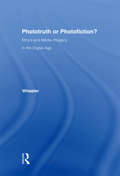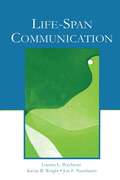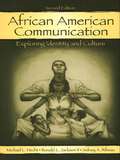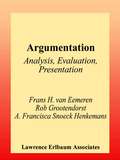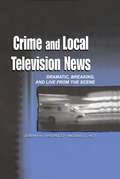- Table View
- List View
Health Communication in Practice: A Case Study Approach
by Eileen Berlin RayHealth Communication in Practice: A Case Study Approach offers a comprehensive examination of the complex nature of health-related communication. This text contains detailed case studies that demonstrate in-depth applications of communication theory in real-life situations.With chapters written by medical practitioners as well as communication scholars, the cases included herein cover a variety of topics, populations, contexts and issues in health communication, including:*provider-recipient communication and its importance to subsequent diagnosis and treatment;*decision-making;*social identity, particularly how people redefine and renegotiate their social identity;*communication dynamics within families and with health care providers through unexpected health situations;*delivery of health care; and*health campaigns designed to disseminate health-related information and change behaviors.Reflecting the changes in health communication scholarship and education over the past decade, chapters also explore current topics such as delivering bad news, genetic testing, intercultural communication, grieving families, and international health campaigns. A list of relevant concepts and definitions is included at the end of each case to help students make connections between the scenario and the communication theories it reflects.With its breadth of coverage and applied, practical approach, this timely and insightful text will serve as required reading in courses addressing the application of communication theory in a health-related context.
Building Theories of Organization: The Constitutive Role of Communication (Routledge Communication Series)
by Linda L. Putnam Anne M. NicoteraThis volume explores the concept of communication as it applies to organizational theory. Bringing together multiple voices, it focuses on communication’s role in the constitution of organization. Editors Linda L. Putnam and Anne Maydan Nicotera have assembled an all-star cast of contributors, each providing a distinctive voice and perspective. The contents of this volume compare and contrast approaches to the notion that communication constitutes organization. Chapters also examine the ways that those processes produce patterns that endure over time and that constitute the organization as a whole. This collection bridges different disciplines and serves a vital role in developing dimensions, characteristics, and relationships among concepts that address how communication constitutes organization. It will appeal to scholars and researchers working in organizational communication, organizational studies, management, sociology, social collectives, and organizational psychology and behavior.
Classroom Communication and Instructional Processes: Advances Through Meta-Analysis
by Barbara Mae Gayle Raymond W. Preiss Nancy Burrell Mike AllenThis volume offers a systematic review of the literature on communication education and instruction. Making meta-analysis findings accessible and relevant, the editors of this volume approach the topic from the perspective that meta-analysis serves as a useful tool for summarizing experiments and for determining how and why specific teaching and learning experiences have positive student outcomes. The topics covered here are meaningful and relevant to classroom practice, and each chapter offers a summary of existing quantitative social science research using meta-analysis. With contributions from experienced researchers throughout the communication discipline, this work provides a unique analysis of research in instructional communication.Taken together, the chapters in this volume enhance understanding of behaviors, practices, and processes that promote positive student outcomes. This book is a must-read for scholars, graduate students, and researchers in communication education, and will also be of interest to scholars and researchers in education.
Classroom Communication and Instructional Processes: Advances Through Meta-Analysis
by Barbara Mae Gayle Raymond W. Preiss Nancy Burrell Mike AllenThis volume offers a systematic review of the literature on communication education and instruction. Making meta-analysis findings accessible and relevant, the editors of this volume approach the topic from the perspective that meta-analysis serves as a useful tool for summarizing experiments and for determining how and why specific teaching and learning experiences have positive student outcomes. The topics covered here are meaningful and relevant to classroom practice, and each chapter offers a summary of existing quantitative social science research using meta-analysis. With contributions from experienced researchers throughout the communication discipline, this work provides a unique analysis of research in instructional communication.Taken together, the chapters in this volume enhance understanding of behaviors, practices, and processes that promote positive student outcomes. This book is a must-read for scholars, graduate students, and researchers in communication education, and will also be of interest to scholars and researchers in education.
Qualitative Research in Journalism: Taking It to the Streets
by Sharon Hartin IorioThis volume highlights the integration of qualitative research methods into traditional journalism, offering new ways of expanding and enhancing news coverage. Designed for readers without prior experience in social science research, this collection presents a wide variety of qualitative techniques and their applications in journalistic practice. The work brings together contributions from professional journalists and journalism scholars who are highly experienced in conducting qualitative research. These experts demonstrate how valid, reliable qualitative procedures can be used to increase coverage and offer new insights. Written in a straightforward, reader-friendly style, features in this volume include: *real-world examples from contemporary newsrooms and interviews with practicing journalists who use the techniques of qualitative research in reporting; *a rationale for the use of qualitative methods in journalism, with an illustration of how various qualitative methods tie together; *step-by-step instructions for applying each methodology; *a solid foundation for understanding the history and theory behind qualitative research and its usefulness in journalism; *chapters on pairing qualitative and quantitative methods in journalism and on detailing partnerships between academics and professional journalists to facilitate newsroom research and reporting; and *a discussion of "objectivity" in qualitative research and in journalism that offers an ethic for journalists of today. The methodologies covered here include oral and life histories, textual analysis, focused interviews, ethnographies, focus groups, and case studies. In addition, a recently developed technique, civic mapping, is presented as a qualitative tool for reporting. Qualitative Research in Journalism is an indispensable resource for current and future journalists interested in enhancing their coverage of the news.
Qualitative Research in Journalism: Taking It to the Streets
by Sharon Hartin IorioThis volume highlights the integration of qualitative research methods into traditional journalism, offering new ways of expanding and enhancing news coverage. Designed for readers without prior experience in social science research, this collection presents a wide variety of qualitative techniques and their applications in journalistic practice. The work brings together contributions from professional journalists and journalism scholars who are highly experienced in conducting qualitative research. These experts demonstrate how valid, reliable qualitative procedures can be used to increase coverage and offer new insights. Written in a straightforward, reader-friendly style, features in this volume include: *real-world examples from contemporary newsrooms and interviews with practicing journalists who use the techniques of qualitative research in reporting; *a rationale for the use of qualitative methods in journalism, with an illustration of how various qualitative methods tie together; *step-by-step instructions for applying each methodology; *a solid foundation for understanding the history and theory behind qualitative research and its usefulness in journalism; *chapters on pairing qualitative and quantitative methods in journalism and on detailing partnerships between academics and professional journalists to facilitate newsroom research and reporting; and *a discussion of "objectivity" in qualitative research and in journalism that offers an ethic for journalists of today. The methodologies covered here include oral and life histories, textual analysis, focused interviews, ethnographies, focus groups, and case studies. In addition, a recently developed technique, civic mapping, is presented as a qualitative tool for reporting. Qualitative Research in Journalism is an indispensable resource for current and future journalists interested in enhancing their coverage of the news.
Nonverbal Communication in Close Relationships
by Laura K. Guerrero Kory FloydNonverbal Communication in Close Relationships provides a synthesis of research on nonverbal communication as it applies to interpersonal interaction, focusing on the close relationships of friends, family, and romantic partners. Authors Laura K. Guerrero and Kory Floyd support the premise that nonverbal communication is a product of biology, social learning, and relational context. They overview six prominent nonverbal theories and show how each is related to bio-evolutionary or sociocultural perspectives. Their work focuses on various functions of nonverbal communication, emphasizing those that are most relevant to the initiation, maintenance, and dissolution of close relationships. Throughout the book, Guerrero and Floyd highlight areas where research is either contradictory or inconclusive, hoping that in the years to come scholars will have a clearer understanding of these issues. The volume concludes with a discussion of practical implications that emerge from the scholarly literature on nonverbal communication in relationships – an essential component for understanding relationships in the real world. Nonverbal Communication in Close Relationships makes an important contribution to the development of our understanding not only of relationship processes but also of the specific workings of nonverbal communication. It will serve as a springboard for asking new questions and advancing new theories about nonverbal communication. It is intended for scholars and advanced students in personal relationship study, social psychology, interpersonal communication, nonverbal communication, family studies, and family communication. It will also be a helpful resource for researchers, clinicians, and couples searching for a better understanding of the complicated roles that nonverbal cues play in relationships.
Nonverbal Communication in Close Relationships
by Laura K. Guerrero Kory FloydNonverbal Communication in Close Relationships provides a synthesis of research on nonverbal communication as it applies to interpersonal interaction, focusing on the close relationships of friends, family, and romantic partners. Authors Laura K. Guerrero and Kory Floyd support the premise that nonverbal communication is a product of biology, social learning, and relational context. They overview six prominent nonverbal theories and show how each is related to bio-evolutionary or sociocultural perspectives. Their work focuses on various functions of nonverbal communication, emphasizing those that are most relevant to the initiation, maintenance, and dissolution of close relationships. Throughout the book, Guerrero and Floyd highlight areas where research is either contradictory or inconclusive, hoping that in the years to come scholars will have a clearer understanding of these issues. The volume concludes with a discussion of practical implications that emerge from the scholarly literature on nonverbal communication in relationships – an essential component for understanding relationships in the real world. Nonverbal Communication in Close Relationships makes an important contribution to the development of our understanding not only of relationship processes but also of the specific workings of nonverbal communication. It will serve as a springboard for asking new questions and advancing new theories about nonverbal communication. It is intended for scholars and advanced students in personal relationship study, social psychology, interpersonal communication, nonverbal communication, family studies, and family communication. It will also be a helpful resource for researchers, clinicians, and couples searching for a better understanding of the complicated roles that nonverbal cues play in relationships.
Phototruth Or Photofiction?: Ethics and Media Imagery in the Digital Age
by Thomas H. WheelerThis text examines the use of images in journalistic contexts and the manipulation of these images to accomplish varying objectives. It provides a framework for critical discussion among professionals, educators, students, and concerned consumers of newspapers, magazines, online journals, and other nonfiction media. It also offers a method of assessing the ethics of mass-media photos, which will help visual journalists to embrace new technologies while preserving their credibility. Phototruth or Photofiction? also: *recounts the invention of photography and how it came to be accorded an extraordinary degree of trust; *details how photos were staged, painted, composited and otherwise faked, long before digital technology; *lists contemporary image-altering products and practices; *details many examples of manipulated images in nonfiction media and lists rationales offered in defense of them; *explains how current ethical principles have been derived; *lays groundwork for an ethical protocol by explaining conventions of taking, processing, and publishing journalistic photos; and *offers tests for assessing the appropriateness of altered images in non-fiction media. Each chapter is followed by "Explorations" designed to facilitate classroom discussion and to integrate into those interactions the students' own perceptions and experiences. The book is intended for students and others interested in the manipulation of images.
Phototruth Or Photofiction?: Ethics and Media Imagery in the Digital Age
by Thomas H. WheelerThis text examines the use of images in journalistic contexts and the manipulation of these images to accomplish varying objectives. It provides a framework for critical discussion among professionals, educators, students, and concerned consumers of newspapers, magazines, online journals, and other nonfiction media. It also offers a method of assessing the ethics of mass-media photos, which will help visual journalists to embrace new technologies while preserving their credibility. Phototruth or Photofiction? also: *recounts the invention of photography and how it came to be accorded an extraordinary degree of trust; *details how photos were staged, painted, composited and otherwise faked, long before digital technology; *lists contemporary image-altering products and practices; *details many examples of manipulated images in nonfiction media and lists rationales offered in defense of them; *explains how current ethical principles have been derived; *lays groundwork for an ethical protocol by explaining conventions of taking, processing, and publishing journalistic photos; and *offers tests for assessing the appropriateness of altered images in non-fiction media. Each chapter is followed by "Explorations" designed to facilitate classroom discussion and to integrate into those interactions the students' own perceptions and experiences. The book is intended for students and others interested in the manipulation of images.
Life-Span Communication
by Loretta L. Pecchioni Kevin B. Wright Jon F. NussbaumThis innovative text emphasizes how communicative processes develop, are maintained, and change throughout the life span. Topics covered include language skills, interpersonal conflict management, socialization, care-giving, and relationship development. Core chapters examine specific communication processes from infancy through childhood and adolescence into middle age and later life.In its exploration of the role of communication in human development, this volume:*overviews the theoretical and methodological issues related to studying communication across the life span;*discusses foundations of communication: cognitive processes and language;*examines communication in relational contexts and communication competencies;*considers communication in leisure and the media with relevance to the life-span perspective; and*presents the implications of the life-span perspective for future research. This text is intended to be used in life-span communication courses and in interpersonal communication courses with a life-span focus, at an advanced or graduate level. It may also be used in courses on family communication, aging, and language development. It will serve as a supplemental text for courses in psychology, family studies, personal relationships, linguistics, and language studies.
Life-Span Communication
by Loretta L. Pecchioni Kevin B. Wright Jon F. NussbaumThis innovative text emphasizes how communicative processes develop, are maintained, and change throughout the life span. Topics covered include language skills, interpersonal conflict management, socialization, care-giving, and relationship development. Core chapters examine specific communication processes from infancy through childhood and adolescence into middle age and later life.In its exploration of the role of communication in human development, this volume:*overviews the theoretical and methodological issues related to studying communication across the life span;*discusses foundations of communication: cognitive processes and language;*examines communication in relational contexts and communication competencies;*considers communication in leisure and the media with relevance to the life-span perspective; and*presents the implications of the life-span perspective for future research. This text is intended to be used in life-span communication courses and in interpersonal communication courses with a life-span focus, at an advanced or graduate level. It may also be used in courses on family communication, aging, and language development. It will serve as a supplemental text for courses in psychology, family studies, personal relationships, linguistics, and language studies.
Media Psychology
by David GilesMedia Psychology examines the impact that 21st century media use has on human behavior, from teenage crushes on pop stars to soap fandom in adulthood. It brings together North American communication research with European media research in a variety of disciplines--psychology, sociology, communication and media studies--and in doing so, maps out the territory for media psychology. David Giles argues that psychologists have been guilty of ignoring the influence of the media over the last century, seeing it at best as a minor nuisance that will eventually go away. However, with the increasing prevalence of new electronic forms of mass communication, the media seem to have a greater influence than ever over our daily lives. In this book, Dr. Giles tackles the traditional topics of media psychology--sex, violence, advertising--along with sections on developmental aspects of media influence and the psychology of the audience. He also examines a number of specific media genres--news, sports, soaps, and the increasingly popular audience participation media, such as "reality" and "lifestyle" television. In addition, he asks what light psychology can shed on the popularity of these genres and the response of their audiences. Finally, there are chapters on the increasing influence of the Internet and on the representation of psychology and psychologists themselves in the media.
Media Psychology
by David GilesMedia Psychology examines the impact that 21st century media use has on human behavior, from teenage crushes on pop stars to soap fandom in adulthood. It brings together North American communication research with European media research in a variety of disciplines--psychology, sociology, communication and media studies--and in doing so, maps out the territory for media psychology. David Giles argues that psychologists have been guilty of ignoring the influence of the media over the last century, seeing it at best as a minor nuisance that will eventually go away. However, with the increasing prevalence of new electronic forms of mass communication, the media seem to have a greater influence than ever over our daily lives. In this book, Dr. Giles tackles the traditional topics of media psychology--sex, violence, advertising--along with sections on developmental aspects of media influence and the psychology of the audience. He also examines a number of specific media genres--news, sports, soaps, and the increasingly popular audience participation media, such as "reality" and "lifestyle" television. In addition, he asks what light psychology can shed on the popularity of these genres and the response of their audiences. Finally, there are chapters on the increasing influence of the Internet and on the representation of psychology and psychologists themselves in the media.
Making It in Public Relations: An Insider's Guide To Career Opportunities
by Leonard MogelMaking It in Public Relations is a comprehensive, realistic guide to everything one needs to know when pursuing a successful career in public relations. It is an introduction to public relations, written for students who want or need a definition of the profession to understand what they are moving into as a career. A thorough overview of the various roles and responsibilities involved in PR work, the different types of PR functions and activities, and its application in a variety of settings and scenarios are provided. In fulfilling the book's editorial role, author Leonard Mogel profiles the 10 largest public relations firms, life on the fast track at a small PR firm, how corporate communications is carried on at a large financial institution, and public relations for diverse organizations. It will be of interest to those studying public relations at the university level; recent mass communication, journalism, and public relations graduates; interns in public relations firms; and employees in other fields contemplating a move to this profession.
Making It in Public Relations: An Insider's Guide To Career Opportunities
by Leonard MogelMaking It in Public Relations is a comprehensive, realistic guide to everything one needs to know when pursuing a successful career in public relations. It is an introduction to public relations, written for students who want or need a definition of the profession to understand what they are moving into as a career. A thorough overview of the various roles and responsibilities involved in PR work, the different types of PR functions and activities, and its application in a variety of settings and scenarios are provided. In fulfilling the book's editorial role, author Leonard Mogel profiles the 10 largest public relations firms, life on the fast track at a small PR firm, how corporate communications is carried on at a large financial institution, and public relations for diverse organizations. It will be of interest to those studying public relations at the university level; recent mass communication, journalism, and public relations graduates; interns in public relations firms; and employees in other fields contemplating a move to this profession.
African American Communication: Exploring Identity and Culture
by Michael L. Hecht Ronald L. Jackson Sidney A. RibeauWhat communicative experiences are particular to African Americans? How do many African Americans define themselves culturally? How do they perceive intracultural and intercultural communication? These questions are answered in this second edition of African American Communication: Exploring Identity and Culture. Informing multiple audiences interested in African American culture, from cultural researchers and practitioners to educators, policymakers, and community leaders, this innovative and invaluable resource examines the richness and depth of African American communication norms and patterns, as well as African American identities. Positive and healthy African American identities are centrally positioned throughout the book. Applying the cultural contracts theory and the communication theory of identity, authors Michael L. Hecht, Ronald L. Jackson II, and Sidney A. Ribeau explore relationships among African Americans, as well as between African Americans and European Americans, while highlighting the need for sensitivity to issues of power when discussing race, ethnicity, and culture. This wide-ranging volume provides an extensive review of the relevant literature and offers recommendations designed to encourage understanding of African American communication in a context extending beyond Eurocentric paradigms. Considering African American identity with a communicative, linguistic, and relational focus, this volume: *Defines African American identities by describing related terms, such as self, self-concept, personhood and identity; *Explores Afrocentricity and African American discourse; *Examines the status of African Americans in the United States using census statistics and national studies from other research agencies; *Considers identity negotiation and competence; and *Features a full chapter on African American relationships, including gendered, familial, intimate, adolescent and adult, homosexual, friendship, communal, and workplace relationships. African American Communication: Exploring Identity and Culture begins an important dialogue in the communication discipline, intercultural studies, African American studies and other fields concerned with the centrality of culture and communication as it relates to human behavior. It is intended for advanced students and scholars in intercultural communication, interpersonal communication, communication theory, African American/Black studies, social psychology, sociolinguistics, education, and family studies.
African American Communication: Exploring Identity and Culture
by Michael L. Hecht Ronald L. Jackson Sidney A. RibeauWhat communicative experiences are particular to African Americans? How do many African Americans define themselves culturally? How do they perceive intracultural and intercultural communication? These questions are answered in this second edition of African American Communication: Exploring Identity and Culture. Informing multiple audiences interested in African American culture, from cultural researchers and practitioners to educators, policymakers, and community leaders, this innovative and invaluable resource examines the richness and depth of African American communication norms and patterns, as well as African American identities. Positive and healthy African American identities are centrally positioned throughout the book. Applying the cultural contracts theory and the communication theory of identity, authors Michael L. Hecht, Ronald L. Jackson II, and Sidney A. Ribeau explore relationships among African Americans, as well as between African Americans and European Americans, while highlighting the need for sensitivity to issues of power when discussing race, ethnicity, and culture. This wide-ranging volume provides an extensive review of the relevant literature and offers recommendations designed to encourage understanding of African American communication in a context extending beyond Eurocentric paradigms. Considering African American identity with a communicative, linguistic, and relational focus, this volume: *Defines African American identities by describing related terms, such as self, self-concept, personhood and identity; *Explores Afrocentricity and African American discourse; *Examines the status of African Americans in the United States using census statistics and national studies from other research agencies; *Considers identity negotiation and competence; and *Features a full chapter on African American relationships, including gendered, familial, intimate, adolescent and adult, homosexual, friendship, communal, and workplace relationships. African American Communication: Exploring Identity and Culture begins an important dialogue in the communication discipline, intercultural studies, African American studies and other fields concerned with the centrality of culture and communication as it relates to human behavior. It is intended for advanced students and scholars in intercultural communication, interpersonal communication, communication theory, African American/Black studies, social psychology, sociolinguistics, education, and family studies.
Argumentation: Analysis, Evaluation, Presentation
by Frans H. van Eemeren A. Francisca Henkemans Rob GrootendorstThis book concentrates on argumentation as it emerges in ordinary discourse, whether the discourse is institutionalized or strictly informal. Crucial concepts from the theory of argumentation are systematically discussed and explained with the help of examples from real-life discourse and texts. The basic principles are explained that are instrumental in the analysis and evaluation of argumentative discourse. Methodical instruments are offered for identifying differences of opinion, analyzing and evaluating argumentation and presenting arguments in oral and written discourse. In addition, the book provides a great variety of exercises and assignments to improve the students' skill in presenting argumentation. The authors begin their treatment of argumentation theory at the same juncture where argumentation also starts in practice: The difference of opinion that occasions the evolvement of the argumentation. Each chapter begins with a short summary of the essentials and ends with a number of exercises that students can use to master the material. Argumentation is the first introductory textbook of this kind. It is intended as a general introduction for students who are interested in a proper conduct of argumentative discourse. Suggestions for further reading are made for each topic and several extra assignments are added to the exercises. Special features: * A concise and complete treatment of both the theoretical backgrounds and the practice of argumentation analysis and evaluation. * Crucial concepts from pragmatics (speech act theory, Grice's cooperative principle) presented in a non-technical way; introducing the theory of verbal communication. * Unique coverage of both oral and written presentation of arguments. * Exercises and assignments based on real-life texts from a variety of contexts.
Argumentation: Analysis, Evaluation, Presentation
by Frans H. van Eemeren A. Francisca Henkemans Rob GrootendorstThis book concentrates on argumentation as it emerges in ordinary discourse, whether the discourse is institutionalized or strictly informal. Crucial concepts from the theory of argumentation are systematically discussed and explained with the help of examples from real-life discourse and texts. The basic principles are explained that are instrumental in the analysis and evaluation of argumentative discourse. Methodical instruments are offered for identifying differences of opinion, analyzing and evaluating argumentation and presenting arguments in oral and written discourse. In addition, the book provides a great variety of exercises and assignments to improve the students' skill in presenting argumentation. The authors begin their treatment of argumentation theory at the same juncture where argumentation also starts in practice: The difference of opinion that occasions the evolvement of the argumentation. Each chapter begins with a short summary of the essentials and ends with a number of exercises that students can use to master the material. Argumentation is the first introductory textbook of this kind. It is intended as a general introduction for students who are interested in a proper conduct of argumentative discourse. Suggestions for further reading are made for each topic and several extra assignments are added to the exercises. Special features: * A concise and complete treatment of both the theoretical backgrounds and the practice of argumentation analysis and evaluation. * Crucial concepts from pragmatics (speech act theory, Grice's cooperative principle) presented in a non-technical way; introducing the theory of verbal communication. * Unique coverage of both oral and written presentation of arguments. * Exercises and assignments based on real-life texts from a variety of contexts.
Rumors and Rumor Control: A Manager's Guide to Understanding and Combatting Rumors
by Allan J. KimmelThis book offers a thorough examination of rumors and proposes strategies for organizations to use in combatting rumors that occur both internally and externally. Author Allan J. Kimmel explores the rumor phenomenon and distinguishes it as a distinct form of communication. He looks at psychological and social processes underlying rumor transmission to understand the circumstances under which people invent and circulate rumors. In addition, he examines how rumors are spread--both interpersonally and through mediated processes--and offers strategies for organizations to respond to rumors when they surface and methods for preventing their occurrence. Numerous examples are provided of actual rumor cases for which managers either successfully or unsuccessfully coped, including such companies as Procter & Gamble, McDonald's, Snapple, Pepsi-Cola, and Gerber. Intended to serve as a comprehensive compendium of strategies, this book was written with two objectives in mind. The first is to shed light on the often perplexing phenomenon of rumor by integrating disparate approaches from the behavioral sciences, marketing, and communication fields. The second is to offer a blueprint for going about the formidable tasks of attempting to prevent and neutralize rumors in business contexts. With these dual goals in mind--one theoretical, the other applied--this book will be of equal interest to both academics and managers in a wide range of professional contexts. In addition, it will guide organizational and marketing managers in their efforts to combat the potentially destructive consequences of rumors.
Rumors and Rumor Control: A Manager's Guide to Understanding and Combatting Rumors
by Allan J. KimmelThis book offers a thorough examination of rumors and proposes strategies for organizations to use in combatting rumors that occur both internally and externally. Author Allan J. Kimmel explores the rumor phenomenon and distinguishes it as a distinct form of communication. He looks at psychological and social processes underlying rumor transmission to understand the circumstances under which people invent and circulate rumors. In addition, he examines how rumors are spread--both interpersonally and through mediated processes--and offers strategies for organizations to respond to rumors when they surface and methods for preventing their occurrence. Numerous examples are provided of actual rumor cases for which managers either successfully or unsuccessfully coped, including such companies as Procter & Gamble, McDonald's, Snapple, Pepsi-Cola, and Gerber. Intended to serve as a comprehensive compendium of strategies, this book was written with two objectives in mind. The first is to shed light on the often perplexing phenomenon of rumor by integrating disparate approaches from the behavioral sciences, marketing, and communication fields. The second is to offer a blueprint for going about the formidable tasks of attempting to prevent and neutralize rumors in business contexts. With these dual goals in mind--one theoretical, the other applied--this book will be of equal interest to both academics and managers in a wide range of professional contexts. In addition, it will guide organizational and marketing managers in their efforts to combat the potentially destructive consequences of rumors.
Media Sex: What Are the Issues?
by Barrie GunterThis book examines the representation, impact, and issues relating to the control and regulation of sex in the media. It covers work that has been conducted around the world on the depiction of sex in the mainstream mass media, especially the audio-visual media of film, television, and video, and the alleged effects that such content may have upon media consumers. In addition to reviewing the research on the effects of media sex, the book also examines what is known about public opinion concerning sex in the media. A key theme running through the book is whether the evidence about media sex can be taken at face value. Are the methodologies used by researchers to investigate media sex problematic? Have they yielded data that can be questioned in terms of validity and reliability? Media Sex questions whether media sex poses a serious problem for most viewers of mainstream media. It acknowledges that there may be serious issues relating to the causation of public offense and the cultivation of anti-women attitudes and beliefs that need to be addressed in productions where more extreme forms of sexual conduct are combined with violent and sadistic behavior. With the unrelenting growth of media, media consumers demand and are given greater personal control over the reception of media content. The notion of freedom of speech conflicts with the view that media content needs to be centrally regulated and controlled. This conflict creates problems for regulatory organizations and the legislators in nation states in which freedom of the press is legally protected. The book examines the debate surrounding this conflict.
Media Sex: What Are the Issues?
by Barrie GunterThis book examines the representation, impact, and issues relating to the control and regulation of sex in the media. It covers work that has been conducted around the world on the depiction of sex in the mainstream mass media, especially the audio-visual media of film, television, and video, and the alleged effects that such content may have upon media consumers. In addition to reviewing the research on the effects of media sex, the book also examines what is known about public opinion concerning sex in the media. A key theme running through the book is whether the evidence about media sex can be taken at face value. Are the methodologies used by researchers to investigate media sex problematic? Have they yielded data that can be questioned in terms of validity and reliability? Media Sex questions whether media sex poses a serious problem for most viewers of mainstream media. It acknowledges that there may be serious issues relating to the causation of public offense and the cultivation of anti-women attitudes and beliefs that need to be addressed in productions where more extreme forms of sexual conduct are combined with violent and sadistic behavior. With the unrelenting growth of media, media consumers demand and are given greater personal control over the reception of media content. The notion of freedom of speech conflicts with the view that media content needs to be centrally regulated and controlled. This conflict creates problems for regulatory organizations and the legislators in nation states in which freedom of the press is legally protected. The book examines the debate surrounding this conflict.
Crime and Local Television News: Dramatic, Breaking, and Live From the Scene
by Jeremy H. Lipschultz Michael L. HiltThis volume offers an analysis of crime coverage on local television, exploring the nature of local television news and the ongoing appeal of crime stories. Drawing on the perspectives of media studies, psychology, sociology, and criminology, authors Jeremy H. Lipschultz and Michael L. Hilt focus on live local television coverage of crime and examine its irresistibility to viewers and its impact on society's perceptions of itself. They place local television news in its theoretical and historical contexts, and consider it through the lens of legal, ethical, racial, aging, and technological concerns. In its comprehensive examination of how local television newsrooms around the country address coverage of crime, this compelling work discusses such controversial issues as the use of crime coverage to build ratings, and considers new models for reform of local TV newscasts. The volume includes national survey data from news managers and content analyses from late night newscasts in a range of markets, and integrates the theory and practice of local television news into the discussion. Lipschultz and Hilt also project the future of local television news and predict the impact of social and technological changes on news. As a provocative look at the factors and forces shaping local news and crime coverage, Crime and Local Television News makes an important contribution to the discussions taking place in broadcast journalism, mass communication, media and society, and theory and research courses. It will also interest all who consider the impact of local news content and coverage.
